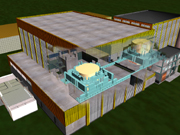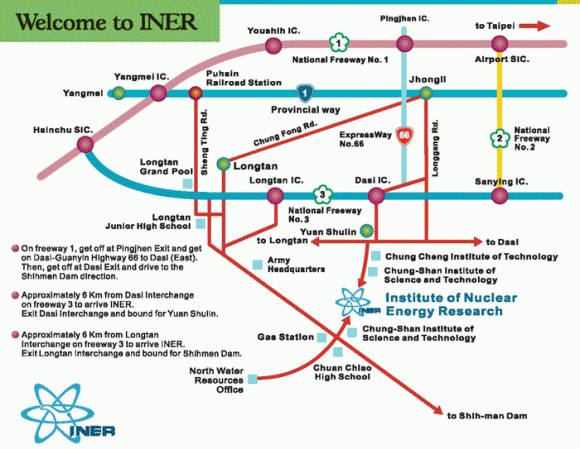Ever seen a picture of the Taiwan Research Reactor? Me neither!
Readers may know that I am very interested in the history of Taiwan’s nuclear weapons efforts, as well as the death of IAEA Inspector Pierre Noir (although I do not suspect foul play). If you are interested in the history of Taiwan’s bomb program, I can’t highly enough recommend David Albright and Corey Hinderstein’s “Nuclear Nightmare Averted” in the Bulletin of Atomic Scientists, along with the two document troves released by the National Security Archive (1|2). And, if Pierre Noir interests you, there is my research with Catherine Dill on the death of the IAEA inspector in 1978: 1|2|3.
A couple of years ago, I found the TRR in satellite images but never put it online. I recently gave the assignment to a student who got close, but couldn’t quite find it. So, here it is, just for the record.
The only image of the TRR I have ever seen is this pretty sad little AutoCAD-like illustration showing the relocation of the reactor core, along with some internal shots showing the decommissioning.
It’s not much but, when combined with the information that the TRR is located at the Institute for Nuclear Energy Research (INER) and probably looks like the NRX Reactor at Chalk River, in Canada, it’s enough. Here is a (pretty terrible) map to the INER site:
The main gate to INER is located at: 24°51’27″N, 121°15’5″E. Once you have the location of INER (as well as the co-located Chung Shan Institute for Science and Technology), the rest is pretty easy. Just take a look around.
The TRR is located at: 24°51’20″N, 121°15’19″E Here is a satellite image you can match to the lousy illustration, as well as the pictures of the NRX. If you fool around with the historical imagery, you can even see external signs of the decommissioning work.




Very interesting. But the similarity to NRX is not a coincidence I guess.
Wasn’t it supplied by AECL? So that would make it perfect for Pu239.
Quite amazing they kept on pushing candu design after the Cirrus disaster in India.
Not an accident. The TRR was 100 percent maple syrup and hockey sticks. Construction predated the Indian nuclear test in 1974.
Maple sirup ;-). Poor canadians.
In principle the candu is a very efficient reactor and and popular for medical and other isotope production. However, without a PUrex plant it doesn’t take you one step closer to a bomb. Does anybody know who provided the Purex equipment? Or is it even indigenous?
Taiwan showed some interest in reprocessing in the 1970s but never succeeded in building a facility. In fact, the discovery of a hot cell associated with the TRR led to the decision to shut the reactor down.
Jeffrey, there’s a small indoors photo of TRR (Taiwan) on the Canadian developer’s website, SNC-Lavalin Nuclear. Scroll down to “Taiwan” at:
http://www.slnuclear.com/history.html
For the record, the textual description they give is (I think they mean MWt not MWe!):
“Taiwan
This 40 MWe multi-purpose research reactor that uses natural uranium fuel, a heavy water moderator and light water cooling was supplied to the Atomic Research Council of Taiwan in 1973. SNC-Lavalin Nuclear provided design, project management services, technical supervision of construction, procurement, inspection services and commissioning assistance. The Engineers devised a major technical innovation by fabricating the calandria entirely in zircalloy – A material which is nearly transparent to neutrons. The company won an Engineering Award of Merit for this innovative design.”
… also a photo of the TRR Zirconium calandria (rector vessel) with some description on pages 6-7 of “Zirconium in Nuclear Applications” edited by J. H. Schemel:
http://books.google.co.uk/books?id=TX7tQKVzeJkC
Most interesting bit of the text is:
“based generally on the NRX … most significant departure from the NRX and CIRUS designs … calandaria is constructed entirely of zirconium alloy … rather than aluminum, and it is equipped with a system of sprays to cool its interior with heavy water.” Also gives the calandaria dimensions.
Also a couple of close-up photos of experiments around the core in 1982 Los Alamos paper LA—-9432-MS. The photos are terrible in the PDF, but maybe in a paper copy they’d be OK:
http://www.iaea.org/inis/collection/NCLCollectionStore/_Public/14/728/14728919.pdf
Out of curiosity… so light water was flowing through the pressure tubes as coolant? How is it possible then to still use natural uranium as fuel?
Wouldn’t too many neutrons be captured? I read that the ACR1000 will also be cooled by light water but still the moderator will be heavy water. However, AECL states SEU will be used as fuel…
The calandria was filled with heavy water to moderate the nuclear reactions. The light water coolant circulated through an independent loop through the calandria.
They did indeed mean 40 MWth.
The calandria was filled with heavy water to moderate the nuclear reactions. The light water coolant circulated through an independent loop through the calandria.
Tobias, all the CANDU type reactors use light water cooling. The average neutron will only encounter heavy water. Some won’t; your reactivity budget has to account for those. But it’s a small part.
Actually not true.
http://en.m.wikipedia.org/wiki/CANDU_reactor
In candu6 heavy water is used in the primary circuit.
It strikes me but Candu seems to be a good concept. Why are there
so few if them. Only proliferation concern?
Cheers
Not true.
Candus use heavy water both as moderator and
in the primary loop.
“It strikes me but Candu seems to be a good concept. Why are there so few if them. Only proliferation concern?”
The large quantity of heavy water required is expensive. “Fuel doesn’t need enrichment” has diminished advantage as enrichment has become cheaper and more efficient. The mechanical complexity of online refueling has led to less availability than in light water reactors even though in theory CANDU could achieve higher availability by not shutting down for refueling.
The TRR is an NRX varient, but it should be mentioned to those that don’t know this case history, that the majority of the spent fuel was shipped to the US long ago and dispositioned at Savannah River. What remained in Taiwan is well short of one SQ and Taiwan is disposing it. Moreover, some commenters in the thread have compared NRX directly to Candu. This comparison is quite superficial. NRX doesn’t produce electricity and runs at low pressure. This configuration allows the reactor to pass fuel through at extremely low burnup, if desired by the operator, and NRX is one of the most flexible, and frankly useful, RR designs ever constructed. It played a considerable role in early US testing of USN fuels and LWR fuels — to support US programs. Candu on the other hand, is a pressurized heavy water reactor and this limits the rate at which fuel can be passed through since sealing and unsealing a pressure tube with very high reliability is necessary each time a fuel bundle is added or taken away. If done incorrectly and a leak occurs, the best case is the plant shuts down for maintenance and while about 700MWe goes offline and this is an “anticipated operational occurance.” The worst case is an SBLOCA occurs, if the reload machine fails entirely, that takes the plant offline for a considerable time and qualifies as a minor nuclear accident. As one imagines, the reloads are done by a very sophisticated machine that becomes (via leak test) part of the high pressure primary circuit so that the reactor can operate while refueling. How long fuel stays in a heavy water reactor is very sensitive to build in rate of Pu-240. If you stray over 1000 MWd/MT, you have more than 10% Pu-240. Normal Candu burnups are roughly 15,000 with comparable or higher Pu-240 build in to LWR spent fuel at full burnup. For 94% Pu-239 (US WGPu definition) you need to stay as low as 500 MWd/MT in Candu. The fuel loading machine is not capable to load at this rate. For LWR, the harder spectrum permits roughly 5000 MWd/MT exposure before exceeding 10% Pu-240. It is a misconception that LWR is dramatically more proliferation resistant than Candu PHWR. A typical large LWR could produce comparable quality material at about 1/2 to 2/3 of the rate of a pair of Candu 6 through short cycling LEU fuel. To outrun the LWR, one has to depressurize the Candus and retrofit the fuel loading. This alters the safety case, dramatically changes the thermal hydraulics (lower pressure means lower boiling point), entirely violating the operating license. From an economic point of view, it ends electricity production from the Candu and may require retrofits in the BoP since 1/3 of the heat is no longer converted to electricity and all heat is discharged to the condenser — this suggests the unit must be derated as well. On the other hand, the LWR keeps running at full pressure and producing electricity. It suffers large losses on capacity factor from short cycling and expends a great deal of expensive LEU fuel in about 1/8th the normal time (a similar loss occurs in Candu). Both spent fuels require comparable reprocessing facilities since they’re zirc clad, UOX fuels. The primary differences between the two, regarding proliferation resistance, are efficiency of implementation of IAEA verification under normal burnup ops (Candu typically costs more to Safeguard than LWR) and the ability (at great economic loss) to retrofit a Candu to convert it into a large plutonium production reactor if one is willing to exit from the NPT to start a weapon program since altering the reactor and its ops would not go unnoticed. An NRX-like reactor is an entirely different machine from a Candu from this point of view and should be viewed with suspicion in this day and age — the Arak reactor in Iran for example.
That’s right about the CANDU reactors. The heavy water aspect is an important reason why the U.S. shared responsibility with Canada for the 1974 Indian test. While Canada had provided a basically nonsafeguarded reactor. Washington had made heavy water available, with virtually no controls, so India could operate CANDU.